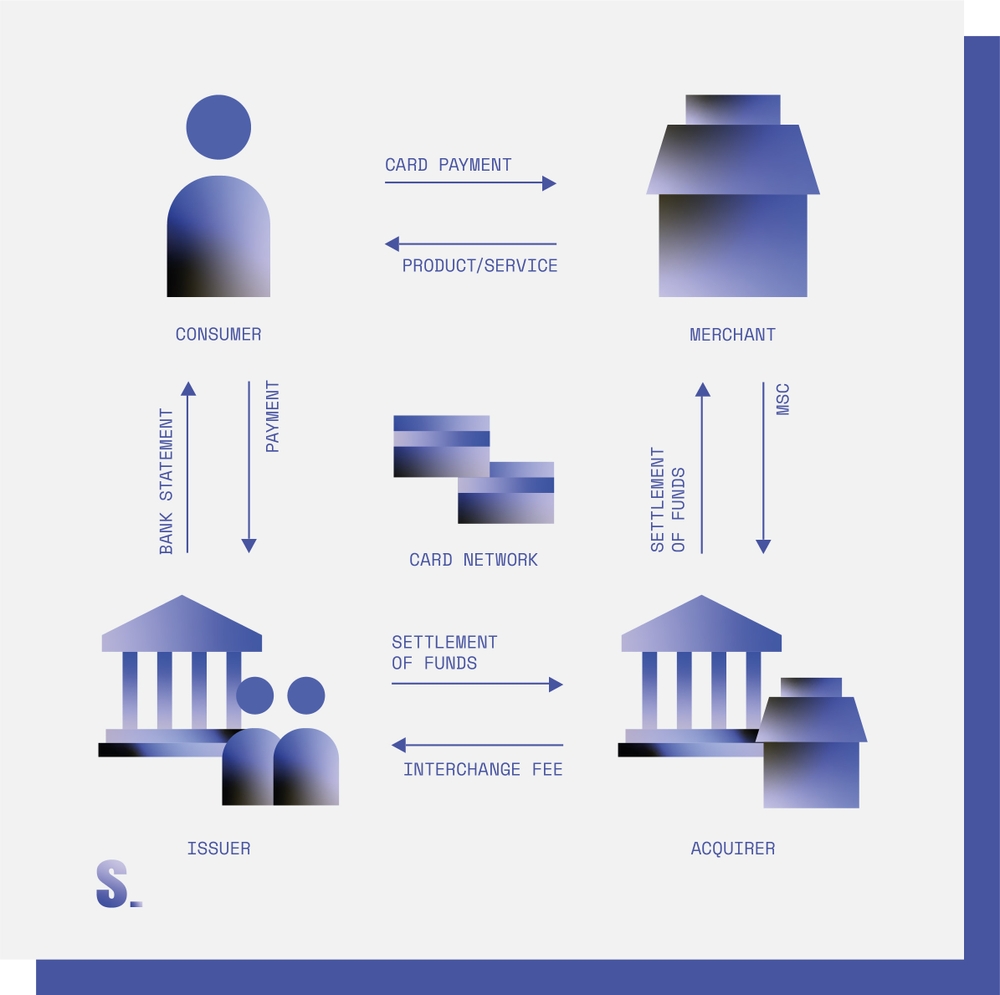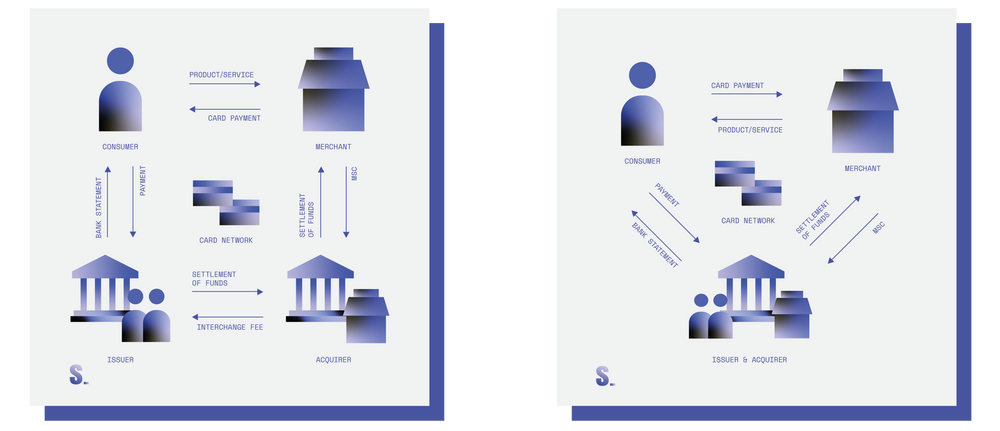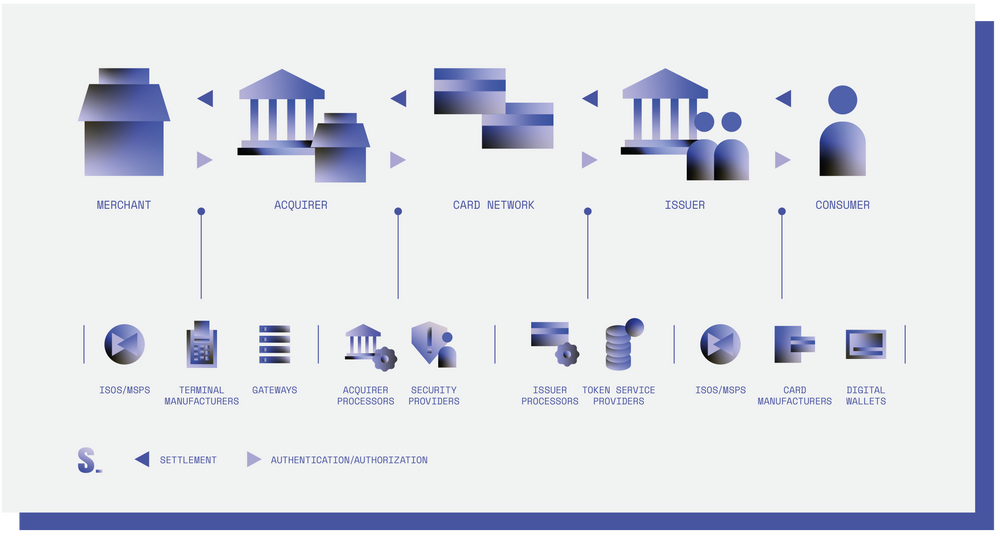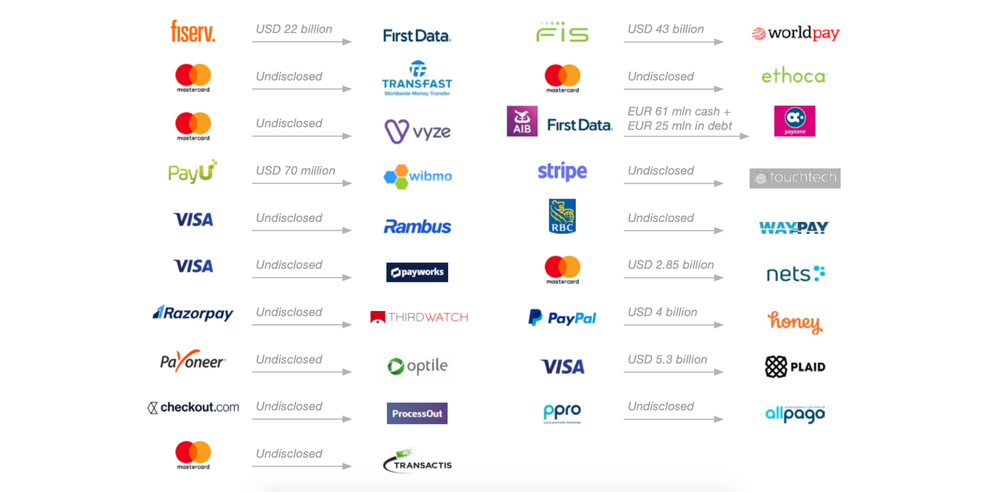And then there were five (key players)
A payment value chain is a system that involves two or more parties that transact funds through a payment scheme. In the most simplified version of it, there’s the payer (consumer) and the payee (merchant). However, as users become more demanding and payment methods become electronic and digital, more entities have stepped up to allow for such technology and systems.
According to Worldpay, digital wallets and cards accounted for more than 79% of e-commerce transactions volume in 2020 and more than 70% of in-store transactions. In both environments and for each payment method, the value chain of payments is typically comprised of five main parties: the customer, the merchant, the issuer, the acquirer, and the card network.

Customer
Commonly referred to as the cardholder if they’re paying with credit or debit cards, customers are the end-users who initiate the payment with the merchant. Within this value chain, customers get the convenience of having an electronic means of paying for goods and services online and offline, with the possibility of entering into multiple rewards and cashback programs.
Merchant
To accept card payments, businesses must open a merchant account — an account established with the acquirer to settle the funds. By being part of this value chain, merchants can attract and retain customers with a fast and efficient buying experience. Merchants are the customers of this payment value chain, as they are interested in receiving payments from the cardholder and need to buy the service from the acquiring bank.
Issuer
An issuing bank, or issuer, is the financial institution that issues cards to customers, provides them with credit or debit accounts, and makes payments on their behalf. Issuers manage payments’ authentication, meaning they receive the transaction information from the acquiring bank and respond by approving or declining the transaction. For approvals, issuers must check in advance to ensure that the transaction information is valid, that the card used belongs to a trusted cardholder, and that the customer has enough funds or credit to perform the transaction. After that, the issuer sends a response code back through the appropriate network to the acquiring bank.
Acquirer
An acquiring bank, also known simply as an acquirer, is the bank or financial institution that provides merchants with the means to accept card payments. The acquiring bank captures the transaction information and routes it through the appropriate card network to the cardholder’s issuing bank for approval, usually through a third-party acquirer processor, a stakeholder covered in the next section. After collecting the payment, the acquirer settles the amount in the merchant account typically within two business days. The amount includes gross sales minus refunds, reversals, disputes, interchange fees, card scheme fees, and acquirer fees.
Card Network
For every card swipe, chip-and-pin, contactless, or CNP (card-not-present) payment, there’s a card network involved — often referenced as a card brand. The card network provides the means for making card transactions possible, and in exchange, acquirers and issuers must pay a license fee — card scheme fee. Card networks pass information and settle funds between the acquirer and the issuer. Besides, they set the standards by which acquirers and issuers should communicate (e.g., ISO 8583 protocol) and define the rules for disputes which standardizes procedures for how issuers and acquirers handle disputes.
Three-party and Four-party Schemes:
A card scheme is a group of entities linked to a card network that agree to follow their set conditions for transacting funds. A card scheme is composed of the cardholder, merchant, acquirer, and issuer. In three-party schemes, the issuer and the acquirer are the same entity. Because of that, there are no fees charged between issuers and acquirers. Examples of card networks that work within three-party schemes are American Express, Discover, and Diners Club.
In four-party schemes, the card network works with multiple and independent entities on the acquiring and issuing side (e.g., issuing banks, acquirer banks, acquirer processors, etc.). This is the case of Visa and Mastercard. Their strategy is to reach as many stakeholders as possible to participate in their network, making room for innovative companies to join, increasing competition and fragmentation within the industry.

There’s more to know about four-party schemes and the economic incentives to maintain such a network. Find out on our blog post ‘You’re Probably Overpaying for Credit Card Processing’
More on the payments industry crew
As the payment industry keeps evolving online and offline and more stakeholders offer innovative or specialized payment services, the payment value chain becomes more complex. In reality, there’s a sheer number of intermediaries who participate in the payment journey from the moment the customer swipes a card on the terminal until the funds are settled on the merchant account.

Acquirer Processors
Acquirer processors provide the technical capabilities to communicate authorization and settlement messages between the acquirer and the card networks. They handle the technical side of the acquiring business and don’t assume financial liability for the process, as they are not involved in fund management. Liability and risk lie on the acquirer. Nonetheless, it’s important to note that, in some cases, the acquiring bank and acquirer processor are a single entity (e.g., Adyen, Elavon).
Examples: Redsys, Monext, Elavon.
Payment Service Providers
A payment service provider (PSP) is a payment institution that offers merchants connections with multiple acquirers and payment methods like credit cards, direct debit, bank transfers, and other value-added services like split-payments anti-fraud, fx settlements. They provide a merchant account and the technology to ensure that businesses can collect and manage their payments seamlessly, including payment gateways, back-offices, plugins, and anti-fraud systems.
PSPs' most prominent value-added feature is their ability to streamline the onboarding process—serving as distributors for acquirers—and to offer a turnkey solution for payments. This means merchants can create one merchant account only and still get access to multiple payment schemes and a centralized reconciliation process.
Examples: Stripe, Adyen, Mollie.
Payment Gateways
A payment gateway represents a technical layer that collects payment credentials on the merchants’ client-side and securely forwards them to the relevant payment service provider (PSP) or acquirer. The majority of gateway companies also offer other value-added services like fraud management or smart routing.
Examples: Switch, PAY.ON, Braintree.
Independent Sales Organizations
An Independent Sales Organization (ISO), also called a Merchant Service Provider (MSP), is a third-party sales organization that acts as a distribution channel for acquiring banks, payment service providers, or payment processors. ISO’s promote and resell credit and debit card services from these institutions to merchants. ISO’s don’t own a payment institution or an acquiring license.
Examples: Braintree, Stripe, Square, Verifone.
Security Providers
With the exponential growth of e-commerce and fraud, keeping payments secure has become a top priority for merchants. Payment security providers develop and provide merchants with the technology to decrease risk exposure during merchant’s transactions, keep card payments safe, and secure them from fraudsters. Security providers’ technology generally includes big data analytics and artificial intelligence.
Examples: Feedzai, Forter, Riskified.
Digital Wallets
A digital wallet, also referred to as an e-wallet, allows an individual to make electronic transactions. It is a software-based system that securely stores users’ payment information and passwords for numerous payment methods and websites. E-wallets can be used for purchasing items online or buy items at a store using smartphones. The money can be deposited in the digital wallet before any transactions, or an individual’s bank account can be linked to the digital wallet. Digital wallets bring customers the added convenience of making payments without carrying cards.
Examples: Paypal, Google Pay, Apple Pay
Do you want to know more about other Alternative Payment Methods? Check our article ‘The Spread of Alternative Payment Methods through E-commerce’.
Terminal Manufacturers and Vendors
POS (point-of-sale) terminals — the devices and technology used to process in-store electronic payments — are developed by terminal manufacturers and distributed by terminal vendors. In some cases, the terminal vendor can be a separate entity from the terminal manufacturer. For example, Adyen distributes POS devices developed by Verifone, a terminal manufacturer. When it comes to the POS hardware and software, different entities can be responsible for developing each. At Switch, we have developed a POS terminal software, the Switch Terminal Application, while certified terminal manufacturers build the available physical devices.
Examples: Castles, Ingenico, Verifone.
What makes the payment landscape so complex?
Things would be pretty straightforward if the payment industry relied only on a couple of stakeholders and if these were easily identified as separated entities. But you’ve seen that’s not the case.
Besides the twelve players covered in this article, many others have been joining the arena as the industry and technology keep evolving. In such a fragmented industry, you’ll find more intermediaries along the way, and these stakeholders can have different roles simultaneously. For example, Adyen is a payment service provider. Still, they also work as an acquirer processor, they own an acquiring license, they use their own payment gateway, and as seen, Adyen sells POS terminals, which also makes them terminal vendors.
Another thing that adds more complexity to this industry is the number of acquisitions among its players. Instead of building these solutions in-house and from scratch, we commonly see payment companies acquiring other companies to offer broader solutions to their clients. In a report by The Paypers about the key payment providers in 2020, we can find the year’s most significant acquisitions. For example, Visa acquired Payworks to strengthen tokenization capabilities beyond Visa card-based payments. On the other hand, Stripe acquired Touchtech to prepare for European regulations on strong customer authentication (SCA).

You’re now familiarized with concepts like issuer, acquirer, payment service provider, and payment gateway, and you’re more prepared to step into any payment-related content and understand these players’ roles and how they connect to each other. Although we’ve covered some relevant stakeholders, the list goes on as the industry keeps expanding. Feel free to reach out if you’d like us to cover more players and their roles in the industry.
In our next article on the payments landscape, we will cover the topic of transaction fees, how these different institutions make money, and who pays what to whom within the payments value chain. If you want to be notified about upcoming articles, sign up for our newsletter here.